| MOVING ON
San Diego: More than a Beach
by Ellen Britz Gerber
Beyond White Sand Beaches
I was kind of surprised. I’d heard basically two things about San Diego: The climate is perfect, and it’s home to several major military installations. 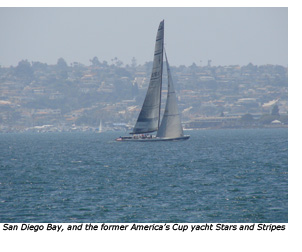 Oh—three things: It also boasts the wonderful San Diego Zoo. When I traveled there to visit my son, my assumptions were confirmed: I did find the climate to be perfect and the naval presence huge. And the San Diego Zoo was, indeed, wonderful. But what I also found was that life exists beyond the white sand beaches and distant naval carriers. In fact, the life that’s taken root in the formerly neglected inner city heralds an absolutely thriving downtown. Oh—three things: It also boasts the wonderful San Diego Zoo. When I traveled there to visit my son, my assumptions were confirmed: I did find the climate to be perfect and the naval presence huge. And the San Diego Zoo was, indeed, wonderful. But what I also found was that life exists beyond the white sand beaches and distant naval carriers. In fact, the life that’s taken root in the formerly neglected inner city heralds an absolutely thriving downtown.
The transformation became apparent to me as my husband, son, and I lounged in the leather sofas of a wine and beer bar, sipping our drinks, caught up in an ambience both unique and familiar. As we were to learn, San Diego, nestled against the Pacific Ocean and home to some of the best surfing in North America, was also the purveyor of a world-class culture, outdoor cafes, fine dining, and so much more.
In a nutshell, there’s a whole lot more to San Diego than sun and surf. For starters, San Diego is the sixth most populous city in the country. (The downtown alone boasts 30,000 residents). The city has the highest number of college graduates in the U.S. and is home to 5 four-year universities and 10 community colleges, many of which offer community education programs. It has a vibrant theater life that gave birth to a variety of Broadway hits, such as Damn Yankees, Tommy, and How to Succeed in Business Without Really Trying. Unexpectedly, a city that I thought of as “a nice place to visit, but I wouldn’t want to live there,” has become a perfect haven for people (like me) looking to fully embrace their post-child-rearing years. So, for those empty nesters contemplating a move back to the city, I’ve tried to put together a synopsis of the urban attributes I believe they would find most appealing.
Housing
The downtown area has more then 15,000 homes, in the form of condos, rentals, lofts, and attached and detached units. It comprises eight distinct neighborhoods: Core, Columbia, Cortez Hill, East Village (home to the Cask Room wine and beer bar, mentioned earlier), Gaslamp Quarter, Horton Plaza, Little Italy, and Marina. 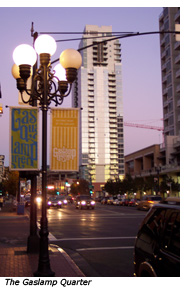 Some neighborhoods, such as the Gaslamp Quarter, are older districts that have undergone a vigorous restoration process. Once a depressed area, the Gaslamp Quarter now displays the charm of restored Victorian housing and old-fashioned gas lamps. Some neighborhoods, such as the Gaslamp Quarter, are older districts that have undergone a vigorous restoration process. Once a depressed area, the Gaslamp Quarter now displays the charm of restored Victorian housing and old-fashioned gas lamps.
Little Italy, earlier home to a highly successful tuna fishing industry and the Italian families who lived and worked there, is now alive with restaurants, cafes, galleries, and specialty shops. It also hosts the popular Art Walk and Festa annual events. The other neighborhoods, each with its own distinct personality, can be glimpsed online through the San Diego Downtown organization.
Costs
In December, the median cost of a home downtown was $490,000, and the average apartment rental would set you back $912/month. An average one-bedroom went for $164,300, a two-bedroom for $270,000, and a three-bedroom, detached residence about $589,000. Obviously, these numbers are quite variable depending on the size of the unit and the location. And, of course, San Diego is not immune to the fluctuations of the housing market, so these prices most likely have dropped.
Transportation
San Diego offers every mode of transportation: trolleys, buses, bike paths, and pedestrian-friendly sidewalks. 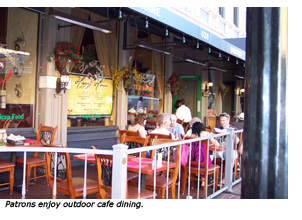 There’s a major airport (Lindbergh Field) nearby, and the San Diego Trolley’s main station connects downtown with the Mexican border. The weather is so beautiful that you will find many people either hoofing it or biking on the road, in designated biking lanes. There’s a major airport (Lindbergh Field) nearby, and the San Diego Trolley’s main station connects downtown with the Mexican border. The weather is so beautiful that you will find many people either hoofing it or biking on the road, in designated biking lanes.
Culture
The city has it all: The San Diego Opera, professional dance companies, concerts (both popular and classical), the museums of Balboa Park (including the San Diego Museum of Art, the Fleet Science Center, and the San Diego Natural History Museum), and rare art galleries. Part of its primacy on the cultural front stems from the master’s program in theatrical arts at the University of California, San Diego—ranked third in the nation. Indoor and outdoor musical venues have hosted events as diverse as the Beach Boys and Elton John, to the San Diego opera.
Crime
For its population size, San Diego is one of the safest cities in the U.S.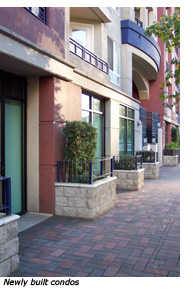 It has also devised an interesting approach to keeping it that way. Local property owners and the Downtown San Diego Partnership's Clean and Safe Program sponsors the Safety Ambassadors, an organization set up to enhance police department services that is funded through property tax assessments. Using two-way radios and patrolling on foot and bicycles, Ambassadors act as an extra set of “eyes and ears” for law enforcement. They operate 24 hours a day and proactively engage the homeless, deter panhandling, and work to prevent vandalism and other unwanted behavior. It has also devised an interesting approach to keeping it that way. Local property owners and the Downtown San Diego Partnership's Clean and Safe Program sponsors the Safety Ambassadors, an organization set up to enhance police department services that is funded through property tax assessments. Using two-way radios and patrolling on foot and bicycles, Ambassadors act as an extra set of “eyes and ears” for law enforcement. They operate 24 hours a day and proactively engage the homeless, deter panhandling, and work to prevent vandalism and other unwanted behavior.
All in all, San Diego may be the quintessential empty nester environment. Exciting, safe, convenient, intellectually stimulating—and a climate made in heaven!
Links:
Urban Living 92101: Real estate and current pricing
The Downtown Living Guide
San Diego Chamber of Commerce
San Diego.com: Hotels, dining, arts, and more
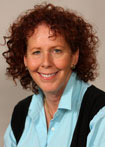 Ellen Britz Gerber is a New York City real estate agent with Weichert Mazzeo Agency and a freelance writer. She is a proud mother of two (her daughter is in law school at Yale and her son has just launched his career as a political reporter in Southern California at Politicker.com). Ellen and her husband traded in their suburban New Jersey home for an apartment in Manhattan about two years ago and have never looked back. Ellen can be reached at ellen@weichertmazzeo.com. You can also share in her New York City musings on her blog. Ellen Britz Gerber is a New York City real estate agent with Weichert Mazzeo Agency and a freelance writer. She is a proud mother of two (her daughter is in law school at Yale and her son has just launched his career as a political reporter in Southern California at Politicker.com). Ellen and her husband traded in their suburban New Jersey home for an apartment in Manhattan about two years ago and have never looked back. Ellen can be reached at ellen@weichertmazzeo.com. You can also share in her New York City musings on her blog. |


 Ellen Britz Gerber is a New York City real estate agent with Weichert Mazzeo Agency and a freelance writer. She is a proud mother of two (her daughter is in law school at Yale and her son has just launched his career as a political reporter in Southern California at Politicker.com). Ellen and her husband traded in their suburban New Jersey home for an apartment in Manhattan about two years ago and have never looked back. Ellen can be reached at ellen@weichertmazzeo.com. You can also share in her New York City musings on her blog.
Ellen Britz Gerber is a New York City real estate agent with Weichert Mazzeo Agency and a freelance writer. She is a proud mother of two (her daughter is in law school at Yale and her son has just launched his career as a political reporter in Southern California at Politicker.com). Ellen and her husband traded in their suburban New Jersey home for an apartment in Manhattan about two years ago and have never looked back. Ellen can be reached at ellen@weichertmazzeo.com. You can also share in her New York City musings on her blog.